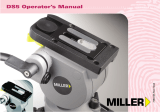Miller BIG BLUE 401DXQ CE, KG191348 Owner's manual
-
Hello! I am an AI chatbot trained to assist you with the Miller BIG BLUE 401DXQ CE Owner's manual. I’ve already reviewed the document and can help you find the information you need or explain it in simple terms. Just ask your questions, and providing more details will help me assist you more effectively!





















